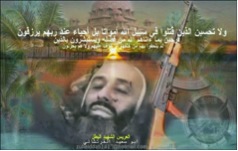
The image depicts the face of a deceased warrior, affiliated with the Islamic International Peacekeeping Brigade (IIPB, or Mezhdunarodnaya Mirotvorcheskaya Brigada), which is now believed to be defunct. His name and epithet appear at the bottom: “al-‘aris al-shahid al-batal Abu Sa‘id al-Qurtasha’i” (“the bridegroom, martyr, hero Abu Sa‘id al-Qurtasha’i”). Centered above the figure’s head, written in white, is a verse from the Qur’an (3:169-170) that reads: “wa-la tahsabanna lladhina qutilu fi sabil Allah amwatan bal ahya’un ‘inda rabbihim yurzaqun, farihina bi-ma ‘atahum Allah min fadlihi, wa-yastabshirun bil-ladhina lam yalhaqu bi-him min khalfihim alla khawfun ‘alayhim wa-la hum yahzunun” (“do not consider those killed in the path of God dead, on the contrary, they are alive, being sustained by God, rejoicing in the grace that God has given them, and delighting in those who have not joined them yet, those who are succeeding them, and for whom they do not fear, nor are they sad”).
Palm trees are shown on both sides of the image. Palms in general, and date palms in particular, are inextricably linked to Mediterranean, Middle Eastern and Islamic cultures. Thus, in jihadi imagery, palm trees are often employed in order to evoke a sense of Arab or Islamic pride and concern. Because of their importance in Islamic history, they can also conjure up notions of the Prophet, his companions and early Islamic history in general. Here though they are likely an evocation of paradise.
A large body of water is also dominant in the image. In general, Islam ascribes the most sacred qualities to water as a life giving, sustaining and purifying resource. It is the origin of all life on earth and the substance from which God created man (Qur’an 25:54). In this specific image, the water element represents the major importance that is placed in Islam upon purity and cleanliness and is used to evoke notions of religious purity, afterlife and heavenly paradise. A shrine or other structure is often paired with what is clearly an expression of death, or common Muslim funerary epigraphy. Inscriptions typically open with the basmalah, though not in the case of this image, and they will contain quotes, paraphrases of or allusions to a Qur’anic text. Most often, the inscription will include the name of the deceased and the date of death. In this image, we have the mosque/shrine, the quote and the deceased’s pseudonyms (Abu Sa‘id al-Qurtasha’i). Finally, it is significant that the image displays the deceased’s bloody face. According to Muslim law, any person who died in defense of his faith is entitled to a Muslim burial without the customary ablution or purification process, or the change of clothing, which is necessary in the case of corpses of those who did not earn the rank of martyr (shahid). The rank of martyrdom renders a corpse legally pure.
 Skip to content
Skip to content
